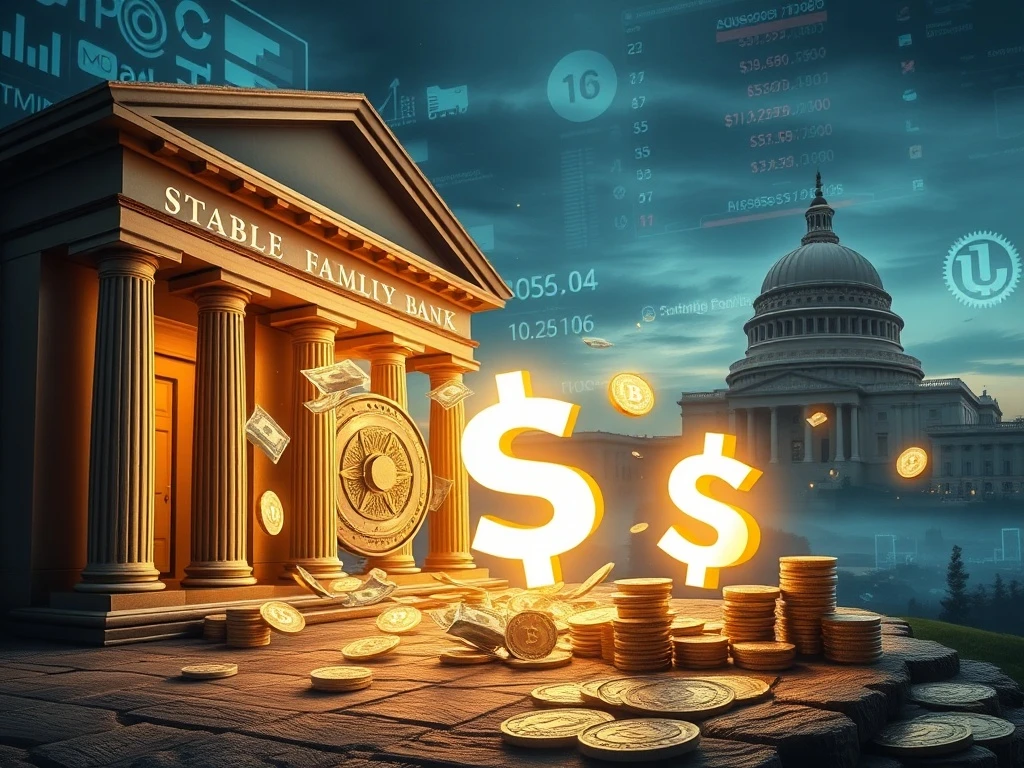Stablecoin Yields: Citi Executive Issues Alarming Warning on Bank Deposit Drain

The financial world is currently buzzing with a critical warning from a major player. A Citi executive recently sounded the alarm, suggesting that attractive stablecoin yields could trigger a significant outflow of bank deposits. This potential shift mirrors historical financial disruptions, posing a profound challenge to the traditional banking sector.
Citi Executive’s Alarming Prediction on Bank Deposits
Ronit Ghose, Citi’s head of Future of Finance, issued a stark warning in a recent report. He cautioned that offering interest on stablecoin holdings could precipitate a wave of bank outflows. This situation, he explained, might resemble the money market fund boom of the 1980s. Ghose’s analysis suggests a concerning parallel between past and potential future financial shifts. In the 1980s, money market funds grew rapidly. They ballooned from approximately $4 billion in 1975 to $235 billion by 1982, according to Federal Reserve data. Banks struggled to compete because their deposit rates faced tight regulation. Consequently, withdrawals from bank accounts exceeded new deposits by $32 billion between 1981 and 1982. This historical context highlights the significant impact that alternative, higher-yielding financial products can have on traditional banking institutions.
The Looming Threat of Stablecoin Yields to the Banking Sector
The potential for stablecoin yields to attract funds away from traditional institutions is a major concern. Sean Viergutz, a banking and capital markets advisory leader at PwC, shares this apprehension. He indicates that a consumer shift towards higher-yielding stablecoins could indeed spell trouble for the traditional banking sector. Viergutz explains the likely consequences for banks. He states, “Banks may face higher funding costs by relying more on wholesale markets or raising deposit rates, which could make credit more expensive for households and businesses.” This scenario implies a ripple effect across the economy. Higher funding costs for banks typically translate into more expensive loans for consumers and businesses alike. Such a development could hinder economic growth and make credit less accessible for many. Therefore, the rise of stablecoin interest offerings presents a complex challenge for financial stability.
Understanding Crypto Regulation and the GENIUS Act
The current regulatory landscape for stablecoins is central to this debate. The GENIUS Act, a key piece of legislation, specifically prohibits stablecoin issuers from directly offering interest to holders. However, it does not extend this ban to crypto exchanges or affiliated businesses. This regulatory setup has sparked considerable controversy and strong reactions from the banking industry. Several influential US banking groups, spearheaded by the Bank Policy Institute, are actively urging regulators to address this perceived loophole. They argue that this indirect allowance for interest or yields on stablecoins could severely disrupt the flow of credit to American businesses and families. Furthermore, these groups warn of potentially massive financial consequences. They project a staggering $6.6 trillion in deposit outflows from the traditional banking system if this loophole remains unaddressed. This figure underscores the gravity of their concerns about the future of bank deposits.
The Crypto Industry’s Stance on Stablecoin Regulation
Unsurprisingly, the crypto industry has pushed back against these banking sector concerns. Two prominent industry organizations have strongly urged lawmakers to reject proposals aimed at closing the alleged “loophole.” They argue that such revisions would unfairly tilt the playing field in favor of traditional banks. Moreover, these organizations contend that such actions would stifle vital innovation within the financial technology space. They also emphasize the importance of preserving consumer choice in financial products. Their position highlights a fundamental difference in philosophy: balancing financial stability with technological advancement. The debate thus pits established financial institutions against a rapidly evolving digital asset ecosystem. This clash of interests complicates efforts to create balanced and effective crypto regulation.
US Dollar Stablecoins: A Strategic Asset for Global Dominance
Amidst this regulatory debate, the US government has emerged as a significant supporter of dollar-pegged stablecoins. Treasury Secretary Scott Bessent articulated this stance in March. He stated that the US government intends to leverage US dollar stablecoins to ensure the dollar retains its status as the world’s dominant global reserve currency. Bessent emphasized the strategic importance of this approach. He explained, “We are going to put a lot of thought into the stablecoin regime, and as President Trump has directed, we are going to keep the US [dollar] the dominant reserve currency in the world, and we will use stablecoins to do that.” This statement underscores a dual objective: fostering innovation in digital finance while simultaneously reinforcing America’s economic leadership. It suggests a future where stablecoins play a critical role in maintaining the dollar’s international standing. This vision contrasts sharply with the banking sector’s immediate concerns about deposit flight.
Navigating the Future: Stablecoin Yields and Financial Evolution
The ongoing discussion about stablecoin yields and their impact on bank deposits highlights a pivotal moment in finance. Regulators face the complex task of balancing innovation with consumer protection and financial stability. The outcome of this debate will undoubtedly shape the future of the banking sector and the broader financial landscape. Will traditional banks adapt their strategies to compete with the attractive returns offered by stablecoins? Or will new crypto regulation emerge to level the playing field? These questions remain central to the evolving narrative. The integration of digital assets, particularly US dollar stablecoins, into the global financial system is inevitable. Therefore, a thoughtful and balanced approach is essential to harness their potential benefits while mitigating risks. This dynamic interplay between traditional finance and the crypto world will continue to be a defining feature of the coming years.








